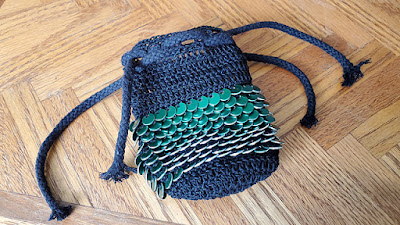I made Montie's first scarf in 2009, which was in my days Before Ravelry (I joined Ravelry on Dec. 1, 2010), so I don't have a Ravelry project page for it. Even so, Montie's scarf was based on my free pattern for Knitted School Scarf based on Harry Potter Hogwarts House Colors, which also existed in my days Before Ravelry. But Montie being Montie, he wanted to put his OWN spin on his scarf, so his request was that I make the stripe sections on each end with three bands of contrasting color while the middle sections have the usual stripe sections with two contrasting bands. He also wanted the contrast stripes to be a bit wider than in the original pattern.
Fast-forward after 11 years of wear and tear and Montie's original scarf (on the left in the above photo) was starting to look a bit ratty with woven ends popping out of place. (This is the one thing I hate about knitting vs. crochet - it's so much easier to keep ends buried in crochet but harder to keep them hidden away in knitting.) I wanted to make a new one for him with the same colors and stripe pattern, except I wanted the new one to be made in a tubular knit style (where the ends can be totally hidden inside!!). You can see the ends poking out of Montie's original scarf in the photo below.
Fortunately Caron still makes the same Dark Country Blue and Sunshine yellow colorways that I used 11 years ago to make the original scarf, so the new one will look nearly identical.
The only difficulty with wanting to reknit another scarf for Montie is how much knitting hurts my hands anymore. So I thought the Sentro knitting machine might be able to help me with this project. I know there are videos on YouTube (like this one and this one, for example) for how to make jogless color changes on the knitting machine, but I haven't figured that technique out yet so I worked this scarf with standard/stepped color changes. I figure I can always make Montie another scarf later when my knitting machine skills are more advanced. 😆
On my first attempt to make the new scarf with the knitting machine I followed the same row counts from the written pattern: I cast on several rows with a waste yarn before starting the first scarf row in blue. I worked a half-height block of 24 rows then a three-stripe section (4 rows in yellow / 6 rows in blue / 4 rows yellow / 6 rows blue / 4 rows yellow). Next a full-height block of 48 rows in blue. Then a two-stripe section (4 rows yellow / 6 rows blue / 4 rows yellow). Then alternated a full-height block in blue followed by a two-stripe section three more times. One more full-height block in blue followed by a three-stripe section and ending with a half-height block in blue. To finish, secure all color changes with knots on the inside of the tube; flat-close the ends of the tube; and secure any remaining ends inside the tube. Scarf is 454 rows total.
Unfortunately at this gauge the 454 rows turned out a scarf that was about 114 inches long, or nearly 9.5 feet. LOL!!! Montie is about 74 inches tall, sooooo ... this scarf is about 3.5 feet too long for him. Bah-ha-ha!
Amazingly, it only took about 4 hours to knit that length on the machine. (And the only reason it took that long was because I was working slowly to be careful with all the color changes and to keep a close eye on it for dropped stitches because this Sentro tries to drop stitches fairly often.) But clearly I was going to have to try again to get the scarf to a more manageable length. The machine produced a fabric of about 4 rows per inch, so to get a finished scarf of a length that's in the ballpark of 74 inches or so I was going to have to fit all the stripes into roughly 300 rows (300/4=75 inches).
My brain doesn't like to math very much, so it took me a couple of days of mulling to come up with a new set of row counts to rework the scarf on the knitting machine. My new plan is to start with a half-height block in blue (16 rows); then a three-stripe section of 2 yellow, 4 blue, 2 yellow, 4 blue, 2 yellow (14 rows); then a full block in blue (32 rows); then a two-stripe section of 2 yellow, 4 blue, 2 yellow (8 rows); [repeat the full block/two-stripes section four more times] (160 rows); one more full block (32 rows); a three-stripe section (14 rows); and lastly a half-block (16 rows). This adds up to 292 rows, which should result in a scarf that's close to 74 inches long.
It took about 2.5 hours to knit the scarf the second time. There is one spot when I was about 3/4 of the way through where I dropped a stitch and didn't see it until a few rows later when the big run opened up. I was about to scream and throw everything into my "to work on again later" pile, but I watched two videos that show how to fix a dropped stitch, this one and this one. I used the crochet hook method in the second video, but you can see in my photo that the fix turned out a little funky. Oh well - this is literally only my second knitting machine project, so I'm not going to freak out over a minor imperfection.












